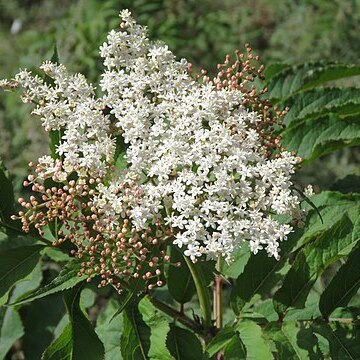Herbs, suffrutescent, or low shrubs, 1-2 m tall, rhizomatous. Pith of roots and rhizomes white or red. Stem herbaceous, obviously striate; pith white or red; lenticels absent. Leaves imparipinnate; stipules bladelike or linear; leaflets 3-5 pairs, narrowly elliptic to narrowly ovate or lanceolate, 4-15 × 1.5-2.5 cm, abaxially sparsely pubescent, more densely pubescent on veins, base obtuse and oblique, margin serrate, apex acuminate; terminal pair of leaflets often connate at base along rachis, sometimes connected also with terminal leaflet, remaining leaflets alternate or sometimes subopposite; stipules of leaflets reduced to urceolate glands. Inflorescences terminal, pedunculate, with 3-5 rays, umbellate cymes, 12-15 cm broad and tall, with dense yellow pubescence when young and ± glandular hairy. Flowers all normal, not reduced to glands, 4-5 mm in diam.; calyx urceolate, pubescent; corolla white; filaments dilated at base, anthers yellow; ovary locules 3; styles short or nearly absent; stigma 3-lobed. Fruit orange or red, becoming black on drying, globose, 3-4 mm in diam.; pyrenes ovoid, ca. 2 × 1.5 mm, rugose or smooth. Fl. May-Jul(-Sep), fr. Sep-Oct. 2n = 36*.
More
A shrub. It grows about 3 m high. The leaves have stalks. They have an odd number of leaflets. The leaflets have short stalks. They are oblong to sword shaped and taper to the tip. They have teeth along the edge and are softly hairy. Flowers are white. They occur in spreading flat topped arrangements at the ends of branches.
It is a subtropical to temperate plant. In China it grows beside streams and on moist shaded mountain slopes and alpine grasslands between 1,600-3,600 m above sea level. In Nepal it grows between 2000-3700 m altitude. It grows in open places. In Sichuan and Yunnan.

